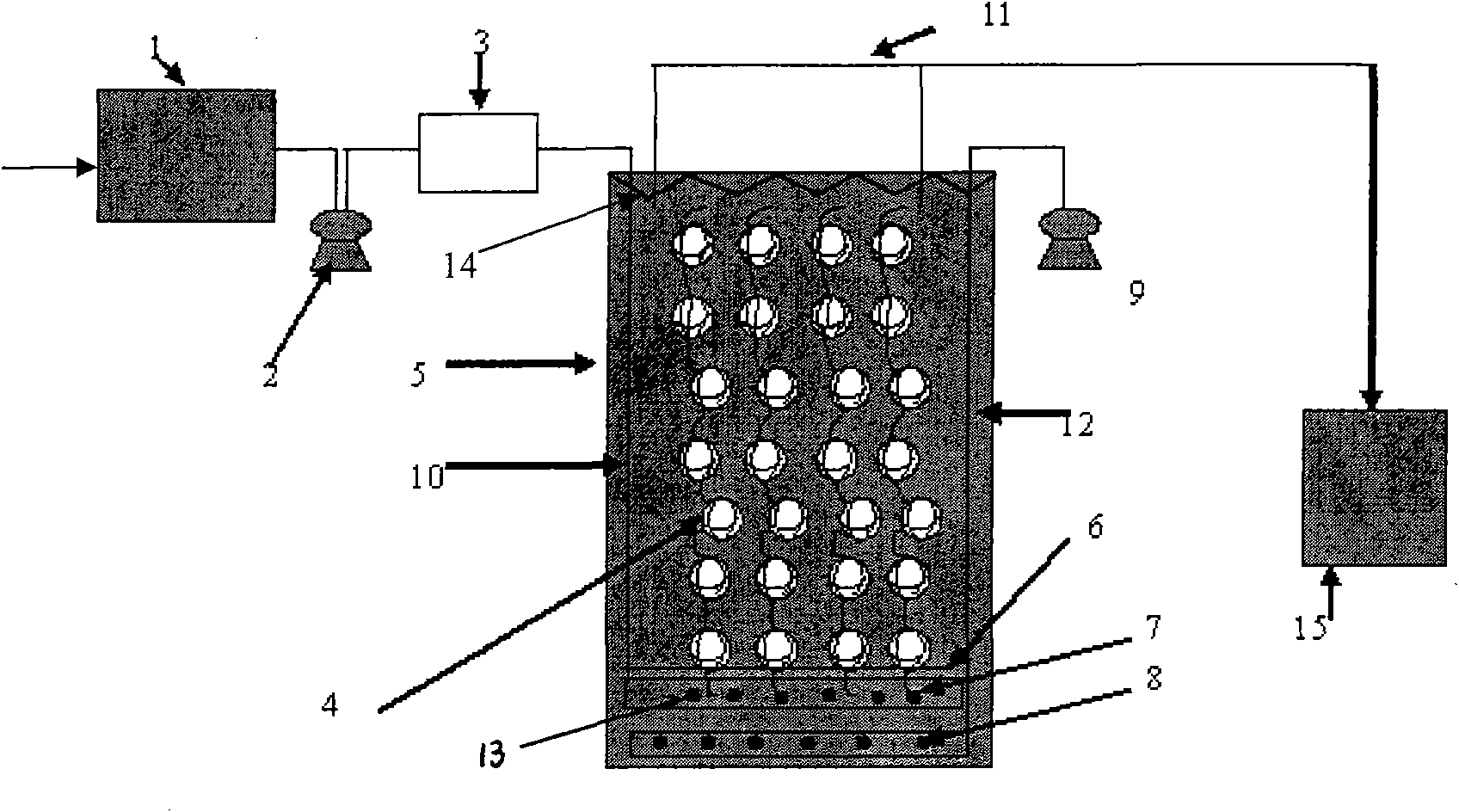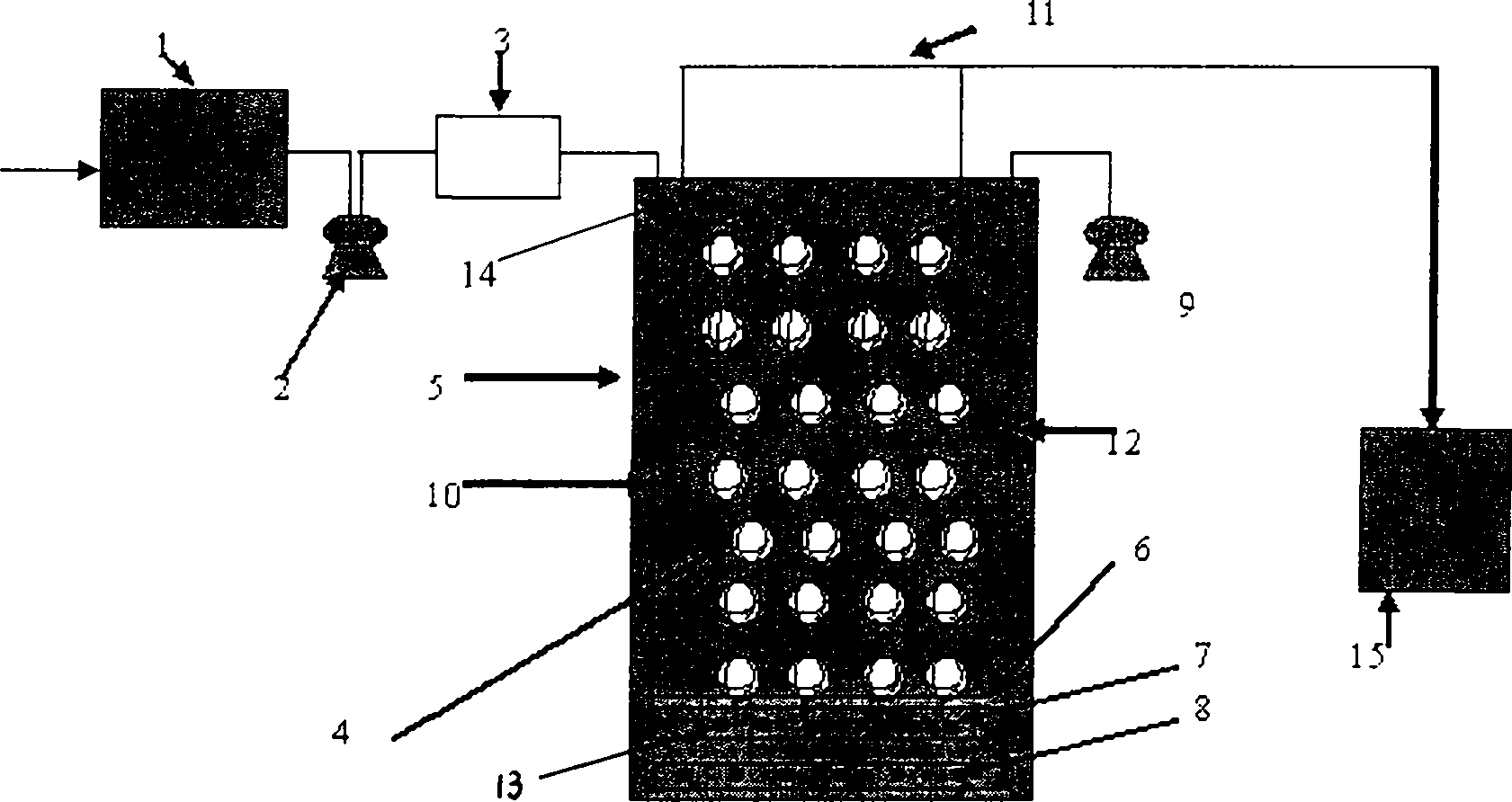Domestic sewage integrated treatment unit
A treatment device and domestic sewage technology, applied in biological water/sewage treatment, water/sewage multi-stage treatment, water/sludge/sewage treatment, etc., can solve problems such as high cost, complicated process, high operation requirements, etc., and achieve improvement Efficiency, simple water quality components, and the effect of promoting oxygen dissolution
- Summary
- Abstract
- Description
- Claims
- Application Information
AI Technical Summary
Problems solved by technology
Method used
Image
Examples
Embodiment 1
[0017] Treatment device: one side of the reaction vessel 5 is provided with a water inlet pipe 10, one end of the water inlet pipe 10 extends to the inner bottom of the reaction vessel 5, and is connected with the aeration pipe 7 of the water inlet system at the bottom of the reaction vessel 5; the other section of the water inlet pipe 10 passes through the inlet The water pump 2 is connected with the primary sedimentation tank 1 automatically controlled by PLC, so that specific sewage enters the reaction vessel 5 . The cross-section of the upper end of the reaction vessel 5 is provided with an overflow tank 14 , the overflow tank 14 is connected to one end of the water outlet pipe 11 , and the other end of the water outlet pipe 11 is connected to the water storage tank 15 . The other side in the reaction vessel 5 is provided with an air intake pipe 12, one end extends to the bottom of the reaction vessel 5, and is connected with the aeration pipe 8 of the air intake system at ...
Embodiment 2
[0025] The difference from Example 1 is that the proportion of sewage is adjusted slightly, the hydraulic retention time and the air-water ratio are adjusted, and the treatment effect under the condition of lower organic load is observed.
[0026] The specific operating parameters are: hydraulic retention time 60min, air-water ratio 9:1, DO 3mg / l, sludge concentration 5000mg / l. The treated effluent water quality (see Table 2).
[0027] Table 2 Sewage Treatment Effect
[0028]
[0029]
[0030] As can be seen from Table 2, when the hydraulic retention time (HRT) was 60min, the COD removal rate had reached 83%, and the BOD 5 Reached 85.7%, ammonia nitrogen, TP removal rates also reached 36% and 38%, respectively, and the number of E. coli was still lower than 3 / L in random detection of water.
Embodiment 3
[0032] The difference from the examples is that the proportion of sewage is slightly adjusted, the hydraulic retention time and the air-water ratio are adjusted, and the treatment effect under relatively high organic load conditions is observed.
[0033] The specific operating parameters of MBR are: hydraulic retention time 120min, air-water ratio 9:1, DO 5mg / l, sludge concentration 6000mg / l. The treated effluent water quality index (see Table 3).
[0034] Table 3 Sewage Treatment Effect
[0035]
[0036] As can be seen from Table 3, when the hydraulic retention time (HRT) was 120min, the COD removal rate had reached 91%, and the BOD 5Reached 87.3%, ammonia nitrogen, TP removal rates also reached 44.6% and 51.6% respectively, and the number of E. coli was still lower than 3 / L in random detection of water. However, an excessively long hydraulic retention time will increase the aeration cost, and may therefore provide insufficient nutrients to affect the concentration of ac...
PUM
| Property | Measurement | Unit |
|---|---|---|
| diameter | aaaaa | aaaaa |
Abstract
Description
Claims
Application Information
 Login to View More
Login to View More - R&D
- Intellectual Property
- Life Sciences
- Materials
- Tech Scout
- Unparalleled Data Quality
- Higher Quality Content
- 60% Fewer Hallucinations
Browse by: Latest US Patents, China's latest patents, Technical Efficacy Thesaurus, Application Domain, Technology Topic, Popular Technical Reports.
© 2025 PatSnap. All rights reserved.Legal|Privacy policy|Modern Slavery Act Transparency Statement|Sitemap|About US| Contact US: help@patsnap.com



